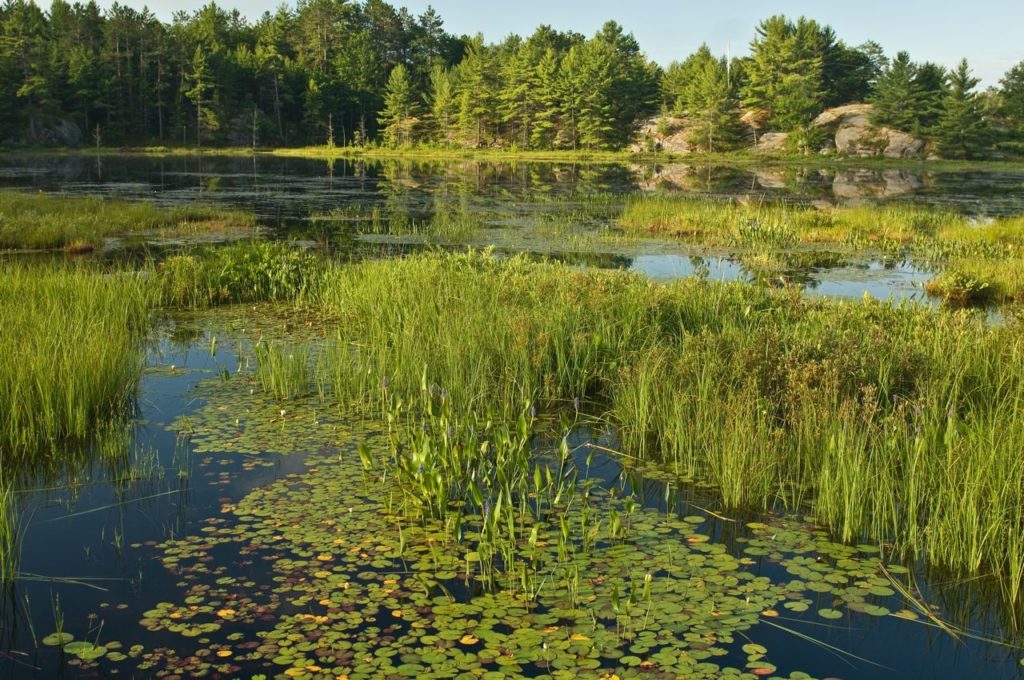The Importance of Natural Infrastructure
By Carley Rennie.

Living in Muskoka, we are accustomed to the exceptional quality of our natural environment, which provides a year-round playground that supports our community. But our environment also provides essential services such as preserving the quantity and quality of our water. Things that humans may construct to provide such services are called “built” or “grey” infrastructure. Aspects of our natural environment which provide such services are called “natural infrastructure”, and the services are known as “ecosystem services”. These ecosystem services sustain our lives and economy. Management agencies are increasingly seeking ways to recognize and sustain these ecosystem services by protecting the natural infrastructure that provides them.
Environments such as forests, coral reefs, wetlands, and lakes naturally filter air and water, manage floods, and create resiliency worldwide. More locally, the Muskoka River Watershed is comprised of approximately 68% forest and 17% surface water. Watersheds with such characteristics provide extensive ecosystem services for those that live in the region, and therefore should be strategically and sustainably maintained for their value as natural infrastructure.
With the increasing costs of maintaining aging built/grey infrastructure (man-made structures such as dams and bridges that are used as control mechanisms), and demands to increase and improve infrastructure to support the needs of modern society, effort has been put in to utilizing natural infrastructure to a higher potential. Continuing to rely solely on built infrastructure is not the most efficient way to manage our landscapes. Incorporating natural infrastructure into the portfolios of communities will provide the same functions as these traditional structures along with being more sustainable for human, environmental, and economic health. The resiliency provided by natural infrastructure becomes particularly important in dealing with the risks posed by climate change.
The impacts of climate change are being experienced across the globe and have already impacted Muskoka; with predictions of warmer and wetter years to come. Maintaining and utilizing ecosystems such as healthy forests, wetlands, and living shorelines throughout Muskoka will have diverse benefits. In order for natural infrastructure to be included in municipal infrastructure planning, funding and support from the private and public sector are necessary to be able to quantify and evaluate these resources. In Canada, the Municipal Natural Assets Initiative (MNAI) works to identify and understand the value of natural assets based on the services they provide.
In places such as Gibsons, British Columbia, using the MNAI framework, natural assets have been included in municipal asset management and financial planning; the first community in North America to do so. In the infrastructure portfolio of the town, natural infrastructure plays an important role, and value is assigned to the services natural assets provide. For example, a local aquifer and naturally occurring ponds in the town were assessed. It was found that the aquifer provides water to over 70% of the population and the ponds provide the same services as stormwater management grey infrastructure that would cost close to half a million dollars per year. Emanuel Machado, CAO for the Town of Gibsons, will speak more to the town’s initiative on natural assets at the next Muskoka Summit on the Environment.
With the climate changing and extreme weather events likely to increase in frequency and severity, investing in climate resilient infrastructure is more important than ever. Creating Climate-Resilient Communities is the theme of the next Muskoka Summit on the Environment, now scheduled for the fall of 2021 due to Covid-19. It is important to recognize that when planning for the future, appropriate use of natural infrastructure can play a vital, and very cost-effective, role in protecting and supporting the environment, community, and economy.
